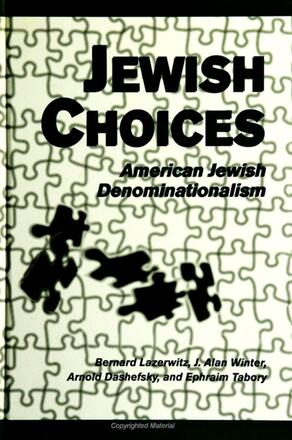
Jewish Choices
American Jewish Denominationalism
Alternative formats available from:
Illustrates how and why Jewish denominational preferences are more a matter of individual choice than family heritage.
Description
Having a religious preference and expressing it via a denominational choice is a fundamental way Americans relate to their society. Similarly, American Jews have divided their religion into four parts—Orthodox, Conservative, Reform, and no preference Jews. This book focuses on how Jewish lifestyles are expressed through denominational affiliation.
The development of American Jewish denominations is viewed as more a matter of individual choice than family heritage. The characteristics of individual adherents of the three major denominations vary systematically as does one's involvement both in local Jewish communities and in the community-at-large. The authors show that as one goes from Orthodox to no preference Jews, the extent of religious expression, ethnic attachments, and Jewish community involvement declines. They project the distribution of denominational preference in 2010 and conclude with recommendations for those who wish to see Jewish identity survive and thrive in America.
Bernard Lazerwitz is Professor Emeritus of Sociology at Bar Ilan University, Israel. His previous work includes Pathways to Suicide: A Survey of Self-Destructive Behaviors (with Ronald Maris) and Americans Abroad: A Comparative Study of Emigrants from the United States (with Arnold Dashefsky, Jan DeAmicis, and Ephraim Tabory). J. Alan Winter is Professor of Sociology at Connecticut College. He is the author of Continuities in the Sociology of Religion: Creed, Congregation and Community; Clergy in Action Training (with Edgard W. Mills and Polly S. Hendrick); and is the editor of The Poor and Vital Problems for American Society (with Jerome Rabow and Marc Chesler). Arnold Dashefsky is Professor of Sociology and Director of the Center for Judaic Studies and Contemporary Jewish Life at the University of Connecticut. His previous work includes Ethnic Identification Among American Jews (with H. M. Shapiro), among others.